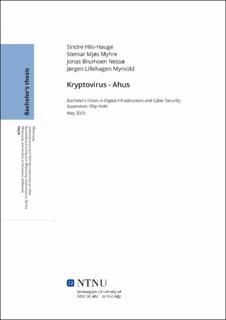| dc.contributor.advisor | Holik, Filip | |
| dc.contributor.author | Hiis-Hauge, Sindre | |
| dc.contributor.author | Myhre, Steinar Mjøs | |
| dc.contributor.author | Nessø, Jonas Brumoen | |
| dc.contributor.author | Myrvold, Jørgen Lillehagen | |
| dc.date.accessioned | 2023-07-01T17:22:30Z | |
| dc.date.available | 2023-07-01T17:22:30Z | |
| dc.date.issued | 2023 | |
| dc.identifier | no.ntnu:inspera:139557333:149159841 | |
| dc.identifier.uri | https://hdl.handle.net/11250/3075204 | |
| dc.description.abstract | I moderne tider blir teknologien stadig mer avansert og sofistikert. Denne hektiske utviklingsprosessen fører til økt risiko for å bli angrepet av ondsinnede aktører på nettet. De mest utbredte truslene av denne typen er kryptovirus, etter som at disse har et bredt antall angrepsvektorer tilgjengelig og er i stand til å forårsake betydelig skade på sine ofre. Derfor har Akershus universitetssykehus (Ahus) bedt om en gjennomgang av konsekvensene av kryptovirusangrep i helsesektoren, på grunn av mange helseforetak er blitt angrepet i Europa og resten av verden. Ahus har også bedt om at denne oppgaven inkluderer et attack tree diagram som dekker informasjon om tidligere angrep utført de siste årene, andre mulige angrepsvektorer som er identifisert, og hvordan et kryptovirusangrep kan påvirke pasientens kvalitetsjusterte leveår (QALYs). | |
| dc.description.abstract | In modern times, technology is becoming more advanced and sophisticated. This hectic process of development leads to an increased risk of being attacked by threat actors on the web. The most prevalent threats of this kind are crypto viruses, as these have a vast amount of attack vectors available, and are capable of causing massive damage to their victims. Thus, Akershus universitetssykehus (Ahus) has requested a review of the consequences of crypto virus attacks in the healthcare sector, due to numerous healthcare companies being attacked in Europe and the rest of the world. Ahus has also requested that this thesis includes an attack tree covering information about previous attacks performed in recent years, possible other attack vectors that are identified, and how a crypto virus attack can affect a patient’s quality-adjusted life years (QALYs). | |
| dc.language | eng | |
| dc.publisher | NTNU | |
| dc.title | Kryptovirus - Ahus | |
| dc.type | Bachelor thesis | |
